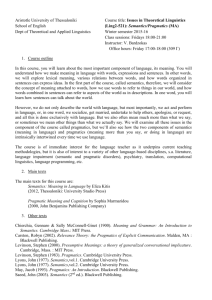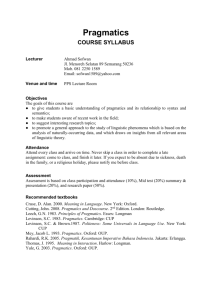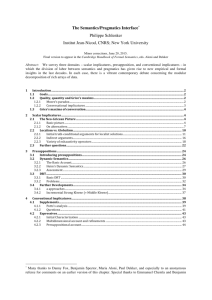June 5 -- Formal semantics and pragmatics
advertisement
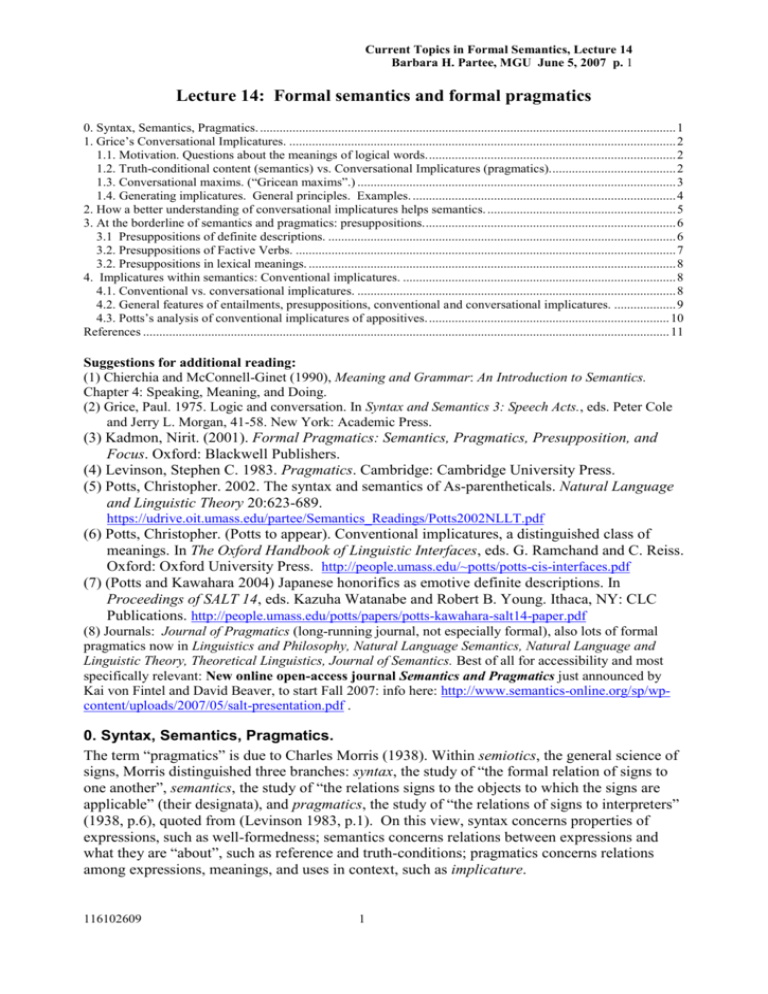
Current Topics in Formal Semantics, Lecture 14 Barbara H. Partee, MGU June 5, 2007 p. 1 Lecture 14: Formal semantics and formal pragmatics 0. Syntax, Semantics, Pragmatics. ................................................................................................................................ 1 1. Grice’s Conversational Implicatures. ....................................................................................................................... 2 1.1. Motivation. Questions about the meanings of logical words. ............................................................................ 2 1.2. Truth-conditional content (semantics) vs. Conversational Implicatures (pragmatics). ...................................... 2 1.3. Conversational maxims. (“Gricean maxims”.) .................................................................................................. 3 1.4. Generating implicatures. General principles. Examples. ................................................................................. 4 2. How a better understanding of conversational implicatures helps semantics. .......................................................... 5 3. At the borderline of semantics and pragmatics: presuppositions. ............................................................................. 6 3.1 Presuppositions of definite descriptions. ........................................................................................................... 6 3.2. Presuppositions of Factive Verbs. ..................................................................................................................... 7 3.2. Presuppositions in lexical meanings. ................................................................................................................. 8 4. Implicatures within semantics: Conventional implicatures. .................................................................................... 8 4.1. Conventional vs. conversational implicatures. .................................................................................................. 8 4.2. General features of entailments, presuppositions, conventional and conversational implicatures. ................... 9 4.3. Potts’s analysis of conventional implicatures of appositives. .......................................................................... 10 References .................................................................................................................................................................. 11 Suggestions for additional reading: (1) Chierchia and McConnell-Ginet (1990), Meaning and Grammar: An Introduction to Semantics. Chapter 4: Speaking, Meaning, and Doing. (2) Grice, Paul. 1975. Logic and conversation. In Syntax and Semantics 3: Speech Acts., eds. Peter Cole and Jerry L. Morgan, 41-58. New York: Academic Press. (3) Kadmon, Nirit. (2001). Formal Pragmatics: Semantics, Pragmatics, Presupposition, and Focus. Oxford: Blackwell Publishers. (4) Levinson, Stephen C. 1983. Pragmatics. Cambridge: Cambridge University Press. (5) Potts, Christopher. 2002. The syntax and semantics of As-parentheticals. Natural Language and Linguistic Theory 20:623-689. https://udrive.oit.umass.edu/partee/Semantics_Readings/Potts2002NLLT.pdf (6) Potts, Christopher. (Potts to appear). Conventional implicatures, a distinguished class of meanings. In The Oxford Handbook of Linguistic Interfaces, eds. G. Ramchand and C. Reiss. Oxford: Oxford University Press. http://people.umass.edu/~potts/potts-cis-interfaces.pdf (7) (Potts and Kawahara 2004) Japanese honorifics as emotive definite descriptions. In Proceedings of SALT 14, eds. Kazuha Watanabe and Robert B. Young. Ithaca, NY: CLC Publications. http://people.umass.edu/potts/papers/potts-kawahara-salt14-paper.pdf (8) Journals: Journal of Pragmatics (long-running journal, not especially formal), also lots of formal pragmatics now in Linguistics and Philosophy, Natural Language Semantics, Natural Language and Linguistic Theory, Theoretical Linguistics, Journal of Semantics. Best of all for accessibility and most specifically relevant: New online open-access journal Semantics and Pragmatics just announced by Kai von Fintel and David Beaver, to start Fall 2007: info here: http://www.semantics-online.org/sp/wpcontent/uploads/2007/05/salt-presentation.pdf . 0. Syntax, Semantics, Pragmatics. The term “pragmatics” is due to Charles Morris (1938). Within semiotics, the general science of signs, Morris distinguished three branches: syntax, the study of “the formal relation of signs to one another”, semantics, the study of “the relations signs to the objects to which the signs are applicable” (their designata), and pragmatics, the study of “the relations of signs to interpreters” (1938, p.6), quoted from (Levinson 1983, p.1). On this view, syntax concerns properties of expressions, such as well-formedness; semantics concerns relations between expressions and what they are “about”, such as reference and truth-conditions; pragmatics concerns relations among expressions, meanings, and uses in context, such as implicature. 116102609 1 Current Topics in Formal Semantics, Lecture 14 Barbara H. Partee, MGU June 5, 2007 p. 2 Much recent work challenges the sharp distinction between semantics and pragmatics implied by the traditional trichotomy. The subdiscipline of formal pragmatics is concerned especially with issues where semantics and pragmatics overlap. Kadmon (2002) and Potts (2005) are good examples of work in formal semantics and pragmatics; Kadmon’s book has a large section on presuppositions and a large section on “association with focus”. Potts investigates conventional implicatures (Section 4 below), and argues that they are a special part of semantics. We begin in sections 1 and 2 with some aspects of pragmatics that are not “formal pragmatics”, but are classic and important, based on the work of Grice (1975). 1. Grice’s Conversational Implicatures. 1.1. Motivation. Questions about the meanings of logical words. It was widely held (before Grice) that there are considerable mismatches between the standard interpretations of the standard connectives and operators of logic ( ‘~’, ‘&’, ‘’, ‘’, ‘x’, ‘x’, ‘x’) and the meanings of their closest counterparts in ordinary English (‘not’, ‘and’, ‘or’, ‘if – then’, ‘every’, ‘some’ (or ‘at least one)’, ‘the’). Some consider natural language rather vague and imprecise and take the logical language as a “regimentation” and an improvement. Others consider natural language richer than and different from the language of formal logic, but not ‘inferior’, and urge the independent investigation of ‘natural logic’ as something distinct from formal logic. Grice does not want to take sides in this debate; he wants instead to challenge its common presupposition. He believes that the meanings of the connectives and operators of standard logic are much closer to the meanings of their natural language counterparts than had been assumed. The reason for the widespread belief to the contrary, he argued, was a failure to distinguish between semantics and pragmatics, a failure to distinguish between the literal semantic content of a sentence (“what is literally said by a sentence”) and a variety of further kinds of inferences that may reasonably be drawn from the speaker’s use of that sentence in a particular context. A speaker may succeed in communicating (intentionally or unintentionally) much more than what is literally said by the words of her sentence. An example: (1) A: How is C getting along in his new job at the bank? B: Oh, quite well, I think; he likes his colleagues, and he hasn’t been to prison yet. What B implied, suggested, or meant is distinct from what B said. All B said was that C had not been to prison yet. 1.2. Truth-conditional content (semantics) vs. Conversational Implicatures (pragmatics). Grice’s new terms: implicate, implicature. “Implicate” is meant to cover the family of uses of “imply”, “suggest”, “mean” illustrated above. Things that follow from what a sentence literally “says” or asserts are called entailments; so the major distinction Grice is drawing is between (semantic) entailments and (pragmatic) implicatures. B’s sentence in (1) entails that C is not in prison; it conversationally implicates that C may have a tendency toward criminal behavior. Example: How many and’s? (2) (a) Mary got married and had a baby. (b) Mary had a baby and got married. (c) Mary got married. She had a baby. (d) Mary got married and had a baby, although not in that order. 116102609 2 Current Topics in Formal Semantics, Lecture 14 Barbara H. Partee, MGU June 5, 2007 p. 3 (3) Tests proved that Jones was the author of the pamphlet(.)/ and (a) he was sent to jail. (b) he was awarded the prize. There have been proposals that and is ambiguous among “logical and”, and then, and therefore, and nevertheless, …. But Gricean principles like “Be orderly” and “Be relevant” can help to defend the semantic non-ambiguity of and. Consider first the hypothesis that and in (2a) and (2b) means “and then”, and the competing hypothesis that what we have in (2a) and (2b) is the ordinary logical conjunction and plus a conversational implicature that the events happened in the order in which the two clauses are given, an implicature that can be derived from the Gricean principle “Be orderly”. The first argument for a single and involves Occam’s razor (“Do not multiply entities unnecessarily.”) If we posit multiple “and”s, how many will we need? Will we have “and then” in (2a-b), a distinct “and therefore” and “and nevertheless” for the sentences in (3), and other kinds of and in other sentences? And doesn’t sentence (3a) strongly suggest both temporal order and cause? So would that require a still different and? For the second argument, we can see in example (2c) that the principle, “Be orderly”, gives rise to the same implicature even without the word and. And a third argument is illustrated with example (2d). Conversational implicatures can be “cancelled” without contradiction: we can see that happening in (2d), which would be contradictory if and in the first clause of (2d) meant “and then”. Thus it seems most reasonable to conclude that the sentential conjunction and is unambiguous: lexical semantics should specify that its truth-conditional meaning is just the meaning of the logical conjunction and. The rest can be explained within pragmatics, using the concept of conversational implicatures. We will describe the principles that generate them, Grice’s “Conversational maxims”. 1.3. Conversational maxims. (“Gricean maxims”.) Conversational partners normally recognize a common purpose or common direction in their conversation, and at any point in a conversation, certain “conversational moves” are judged suitable or unsuitable for accomplishing their common objectives. A most general principle: CP: Cooperative Principle: Make your conversational contribution such as is required, at the stage at which it occurs, by the accepted purpose or direction of the talk exchange in which you are engaged. Under this very general principle, Grice distinguishes four categories of maxims. Note: these maxims are characteristic of conversation as a cooperative activity. Think about which ones would change in a non-cooperative setting, such as between a prosecuting attorney and a defendant, or when having your tax return audited (I could tell an anecdote about the latter case), or when a military commander is giving orders to the troops, or if I am a crook trying to persuade you to buy something worthless. Maxims of Quantity. (i) Make your contribution as informative as is required (for the current purposes of the exchange). (ii) Do not make your contribution more informative than is required. Maxims of Quality. Supermaxim: Try to make your contribution one that is true. (i) Do not say what you believe to be false. (ii) Do not say that for which you lack adequate evidence. 116102609 3 Current Topics in Formal Semantics, Lecture 14 Barbara H. Partee, MGU June 5, 2007 p. 4 Maxim of Relation. (i) Be relevant. Maxims of Manner. Be perspicuous: (i) Avoid obscurity of expression. (ii) Avoid ambiguity. (iii) Be brief (avoid unnecessary prolixity). (iv) Be orderly. The question of why speakers can normally be expected to obey the supermaxim of trying to tell the truth is insightfully discussed in David Lewis’s classic book Convention (Lewis 1969).There are other maxims that are not “conversational” maxims but which may also be observed during conversational exchanges (aesthetic, social, moral), such as “Be polite”. 1.4. Generating implicatures. General principles. Examples. (i) A participant may quietly and unostentatiously violate a maxim. If he does so “quietly”, rather than “cooperatively”, he may mislead. Example: saying (4) when in fact Bill has two wives. This violates one of the maxims of quantity, and would normally be misleading, although it is not false. (4) Bill has a wife (ii) A participant may be faced by a clash. It may be impossible to fulfill one maxim without violating another. For instance, one may be unable to fulfill the first maxim of Quantity (say enough) without violating Quality (only say what you have evidence for.) Example: in conversation (5),B’s answer is less informative than required. Assuming he is not opting out, we can explain the violation if we assume that B could not give a more informative answer without violating the maxim of Quality. So B implicates that he does not know more precisely where C lives. (5) A. Where does C live? B. Somewhere in the south of France. (iii)He may flout a maxim: that is he may blatantly fail to fulfill it. This is similar to violating a maxim, except that in this case the hearer is expected to recognize what is happening, and if so, then the maxim is likely to be being exploited to intentionally generate a conversational implicature. Example: (6) A asks: Where’s Bill? B answers: There’s a yellow VW outside Sally’s house. (Levinson 1983, p. 102) Example: Letter of recommendation: Use Maxim of Relevance to generate the implicature that the letter writer does not have a very high opinion of Mr. X. (7) “Dear Sir, Mr. X’s command of English is excellent, and his attendance at tutorials has been regular. Yours, etc.” Example: A “generalized implicature”. Almost any use of a sentence of the form (8) would normally implicate that the person to be met was not X’s wife, mother, or sister. (Similarly with other indefinites – “X went into a house” implicates that it was not X’s house.) (8) X is meeting a woman this evening. 116102609 4 Current Topics in Formal Semantics, Lecture 14 Barbara H. Partee, MGU June 5, 2007 p. 5 2. How a better understanding of conversational implicatures helps semantics. Intuitively, it often seems that natural language or is often used in an “exclusive” sense: “but not both”. We can easily write a truth-table for exclusive or, which we will represent with the symbol ‘+’. p q p+q pq 1 1 1 0 1 0 1 1 0 1 1 1 0 0 0 0 The question is, is English or (or German oder, or Russian ili) really semantically ambiguous between two truth-conditional connectives? Or can one defend an analysis on which or is semantically always inclusive disjunction, and all the apparent exceptions can be explained as a result of other factors such as Gricean implicatures? 1. Intrinsically mutually exclusive alternatives: Examples like (9) are sometimes given as examples of exclusive disjunction (I even gave such examples in my first textbook). (9) Mary is in Prague or she is in Stuttgart. But (9) does not give any evidence for distinguishing between two kinds of or, because with (9), the first line of the truth table does not arise; we know independently that p and q will not be true simultaneously. 2. Using the (first) Gricean Maxim of Quantity. (10) Mary has a dog or a cat. In this case, the alternatives are not intrinsically incompatible; it is perfectly possible to have both. So is this a case where we should say that or is ambiguous? How else can we explain that in most normal contexts an utterance of (10) would be construed exclusively, but sometimes it is possible to understand it inclusively (for instance, if I am allergic to dogs and cats and can’t stay at the home of anyone with a dog or a cat.)? Answer: Make use of the Gricean maxim: “Make your contribution as informative as is required.” If the speaker had evidence that Mary has a dog and a cat, she could have made the stronger statement (11): (11) Mary has a dog and a cat. In many contexts, it would be relevant to know whether the stronger statement holds, so in many contexts, the use of or signals the absence of evidence for the conjunctive case; and if we believe that the speaker would have known if the conjunction were true, we obtain the implicature that the conjunction is false. In such a case, we can say that semantics allows lines 1 through 3 of the truth table, but the first line may be ruled out pragmatically through implicatures. More generally: whenever the speaker has a choice between a weaker or less specific form and a stronger or more specific form, other things being equal, the use of the weaker form implicates that the speaker does not have evidence that the stronger form is true. And if the speaker is presumed to have full information, that will lead to the implicature that the stronger form is false. Thus “or” plus an assumption of full information implicates “not ‘and’”, and “some” plus assumption of full information implicates “not all”, etc. 3. A strong argument from negation. (12) Mary doesn’t have a dog or a cat. 116102609 5 Current Topics in Formal Semantics, Lecture 14 Barbara H. Partee, MGU June 5, 2007 p. 6 If or were ambiguous between inclusive and exclusive, negating it should be likewise ambiguous, and (12) should have one reading on which it asserts that Mary has either neither or both. But (12) unambiguously asserts the negation of the inclusive or: Mary has neither. 3. At the borderline of semantics and pragmatics: presuppositions. (Levinson 1983, Chs. 3,4, Chierchia and McConnell-Ginet 1990, Ch. 6, Kadmon 2001) A presupposition is (a) backgrounded and (b) taken for granted, i.e. assumed by the speaker to be already assumed by the hearer to be true. A classic definition of semantic presupposition: A sentence S presupposes a proposition p if p must be true in order for S to have a truth-value (to be true or false). *Note that this requires that we allow some sentences to lack a truth-value; this definition does not make sense if we work with a strictly bivalent logic, in which each sentence must be either true or false. An approximate definition of pragmatic presupposition: A use of sentence S in context C pragmatically presupposes p if p is backgrounded and taken for granted by the speaker in C. Test for backgrounding: p is in the background of S if p is implied by all of the sentences in the “S family”: (13) a. S b. It is not the case that S. c. Is it the case that S? d. If S, then S’. Example: (14) “Joan has stopped drinking wine for breakfast.” Presupposition: Joan used to drink wine for breakfast. Backgrounded but not presupposed: non-restrictive relative clauses. (15) Jill, who lost something on the flight from Ithaca to New York, likes to travel by train. A number of authors have considered the embedded proposition, that Jill lost something on the flight from Ithaca to New York, to be a presupposition (Keenan 1971, Levinson 1983), but arguments against considering it a presupposition can be found in Padučeva (1985, p.65) and later in (Chierchia and McConnell-Ginet 1990) and (Kadmon 2001). Contrasting sentence with a real presupposition: Pseudo-cleft construction. (16) What Jill lost on the flight from Ithaca to New York was her new flute. 3.1 Presuppositions of definite descriptions. (17) “After the separation of Schleswig-Holstein from Denmark, Prussia and Austria quarrelled.” This is an example from Frege (1892). Frege states that the thought that Schleswig-Holstein was once separated from Denmark “is the necessary presupposition in order for the expression in (17) to have any reference at all. A classic example discussed by Russell and Strawson is (18). (18) a. The present king of France is bald. b. The present king of France is not bald. Russell analyzed (18b) as ambiguous, treating the conditions of existence and uniqueness as part of the truth-conditions of the sentence. If there is no king of France, (18b) would come out true on Russell’s analysis if negation has wide scope, false if the definite description has wide scope. 116102609 6 Current Topics in Formal Semantics, Lecture 14 Barbara H. Partee, MGU June 5, 2007 p. 7 (Optional exercise: You could work out a Russellian analysis of this kind explicitly by using our fragment, with Montague’s <<e,t>,t> type analysis of “the king”. ) Strawson argued that it is more normal to consider (18b) neither true nor false if there is no king of France. Strawson’s analysis corresponds to our e-type treatment of definite descriptions. If you try to evaluate (18b) using a Strawsonian analysis, assuming there is no king of France, then the subject NP will get no semantic value. And we assume that if one of the parts has no semantic value, then the whole sentence has no semantic value. (19) Chirac is not the king of France. As Strawson noted, a sentence like this does not lack a truth value: it seems to be definitely true. For this example (but not for all), we can capture the absence of presupposition by using the predicative <e,t> meaning of the definite description proposed in (Partee 1986). In other examples, as argued by Hajičová (1984), Theme-Rheme structure may be crucial: a definite description that is part of the Theme (Topic) carries a presupposition of existence and uniqueness; but a definite description that constitutes all or part of the Rheme (Focus) seems to carry only an “allegation”, or cancellable implicature, of existence and uniqueness. (20) a. Our defeat was not caused by Bill’s cousin. b. Bill’s cousin did not cause our defeat. Potential presuppositions: (i) we were defeated. (“our defeat” has a reference.) (ii) Bill has a cousin. Test for cancellability: (21) a. “ ... , in fact Bill does not have a cousin.” (ok after 20a, not after 20b) b. “ ..., in fact this time we achieved a great victory.” (ok after 20b, not after 20a) A good discussion of referential status of a variety of kinds of noun phrases, and their associated presuppositions, can be found in Chapter 4 of (Padučeva 1985). 3.2. Presuppositions of Factive Verbs. Another classic case of presuppositions much studied by linguists are the presuppositions of factive verbs. Let’s consider two sets of verbs and compare their behavior in the sentences in the “S family”. Non-factive verbs Factive verbs believe say hope deny claim know regret be surprised notice discover (22) (a) (b) (c) (d) John said that Bill is a spy. John didn’t say that Bill is a spy. Did John say that Bill is a spy? If John said that Bill is a spy, Mary will be unhappy. None of the sentences in (22) imply that the speaker takes for granted, or even believes, that Bill is a spy, not even the positive assertion (22a). In contrast, all of the sentences in (23) require for appropriate use that the speaker takes for granted that Bill is a spy. (23) (a) (b) (c) (d) 116102609 John knows that Bill is a spy. John doesn’t know that Bill is a spy. Does John know that Bill is a spy? If John knows that Bill is a spy, Mary will be unhappy. 7 Current Topics in Formal Semantics, Lecture 14 Barbara H. Partee, MGU June 5, 2007 p. 8 We get similar results putting any non-factive verb in the pattern in (22) and any factive verb in the pattern in (23). The classic work is (Kiparsky and Kiparsky 1970); there has been much important work since then, including (Karttunen 1971, Karttunen 1973, Gazdar 1979, Karttunen and Peters 1979, Heim 1992). 3.2. Presuppositions in lexical meanings. The division of “components” of lexical meaning into assertive and presuppositional has been emphasized both in the work of Fillmore (1971) and in the work of Apresjan (1974) and his colleagues. Good examples include the contrast discussed by Fillmore among the verbs blame, criticize, accuse, all involving an agent X, an addressee or patient Y, and an action P, and the different status of the components ‘X says/believes that Y did P’, ‘X says/judges that P is/was a bad action’, and ‘X says/believes that P happened’, and the similar contrast discussed by Padučeva (1985, p.67) among the Russian verbs obvinjat’ ‘accuse’ (X obvinjaet Y v P) and osuždat’ ‘criticize’ (X osuždaet Y za P), noting an observation of Langendoen that when an adverb such as spravedlivo ‘justly’ is added to a sentence containing one of these verbs, what is asserted to be “just” is only the asserted part, not the presupposed part. If we follow Frege and take the denotations of most words to be functions, then presuppositions can be treated formally as conditions on the well-definedness of functions. Recall, for instance, our definition of the iota-operator used for the referential sense of the definite article: ιx[king(x)] is defined iff there is one and only one king, and undefined otherwise. In general, when a presupposition (precondition) of a function is not satisfied, the function is not defined and it is impossible to compute a value. (Heim 1983) 4. Implicatures within semantics: Conventional implicatures. 4.1. Conventional vs. conversational implicatures. Grice: distinguished conventional implicatures and conversational implicatures. Conventional implicature: part of the meaning of a word or construction but not part of its truth-conditions. An implicature which arises from the particular choice of words or syntax, rather than from conversational maxims. See (Potts 2002, Potts to appear) From Potts (to appear): (24) a. CIs are part of the conventional (lexical) meaning of words. b. CIs are commitments, and thus give rise to entailments. c. These commitments are made by the speaker of the utterance “by virtue of the meaning of” the words he chooses. d. CIs are logically and compositionally independent of what is “said (in the favored sense)”, i.e., the at-issue entailments. Some authors equate conventional implicature with presupposition, but conventional implicatures can be new information, whereas presuppositions should not be. Examples: (a) manage, (b) too, (c) even, (d) but, (e) the appositive construction, (f) nonrestrictive relative clauses, (g) expressive meaning. (25) (a) John managed to close the door. Assertion: John closed the door. Implicature: The door was hard to close. (b) Susan left the party at midnight, and Maria left the party early too. Assertion: Susan left the party at midnight, and Maria left the party early. Implicature: Midnight was early to leave the party. 116102609 8 Current Topics in Formal Semantics, Lecture 14 Barbara H. Partee, MGU June 5, 2007 p. 9 (c) Even Al passed the test. Assertion: Al passed the test. Implicature: Al was the least likely person to pass the test. There were grounds for expecting that Al would not pass the test. (d) Mary is a linguist, but she’s rich. Assertion: Mary is a linguist, and she is rich. Implicature: Linguists are not usually rich. (e) David Partee, a former president of the Alaska Dog Mushers Association, lives in Fairbanks. Assertion: David Partee lives in Fairbanks. Implicature (conventional): David Partee was the president of the ADMA. (f) Just like (e), but with non-restrictive relative clause ‘who is a former president of the ADMA’. (g) Bob brought his damn dog with him. Assertion: Bob brought his dog with him. Implicature: Speaker has a negative attitude toward the dog, or toward Bob’s bringing the dog with him. Conversational implicature: an implication that follows from general principles of conversational exchanges. Example: some usually conversationally implicates not all, by the Maxim of Quantity. Other examples were given earlier. 4.2. General features of entailments, presuppositions, conventional and conversational implicatures. Classification: (26) a. A entails B (if A is true, B is true.) b. A presupposes B. (B is backgrounded and taken for granted by A.) c. A conventionally implicates B. (The use of A in any normal context implies B, by virtue of the meaning of the expressions in A, but B is not part of the “at-issue” content of A.) d. A conversationally implicates B. (The use of A in the given context (pragmatically) implies B, by virtue of conversational maxims.) Conversational implicatures must possess certain features that distinguish them from conventional implicatures and entailments. (a) Cancellability. Because it is possible to opt out of the observation of the Cooperative Principle, a generalized conversational implicature can be canceled in a particular case, either explicitly or contextually. Conventional implicatures and entailments cannot be canceled. Presuppositions may or may not be cancelable, depending on their source. Examples: See (20-21) above. (b) Non-detachability. The calculation of the presence of a conversational implicature requires only contextual and background information plus a knowledge of the literal meaning of the sentence, then substitution of any other truth-conditionally equivalent expression will preserve the implicature. Conversational maxims mainly work from the content of what is said, independent of any specific word or construction. (By ‘non-detachability’, Grice apparently meant that you cannot get red of the implicature by substituting a different expression with the same literal truth-conditional semantic content.) Entailments are also “non-detachable”, since by definition they depend only on the truth-conditional content of the sentence. Most conventional implicatures are 116102609 9 Current Topics in Formal Semantics, Lecture 14 Barbara H. Partee, MGU June 5, 2007 p. 10 detachable, as in the case of but, truth-conditionally equivalent to and but carrying an implicature not carried by the use of and. (c) Conversational implicata are not part of the conventional meaning of the expressions that serve to generate them. The calculation of the presence of a conversational implicature presupposes already having knowledge of the conventional force of an utterance, so it cannot be part of it. Entailments are part of the conventional meaning of the expression, and so are conventional implicatures. (Potts: conventional implicatures are indeed conventional, but are not part of the “at-issue” meaning.) (d) The truth of a conversational implicatum is not required by the truth of what is said; what is said may be true and what is implicated may be false (and vice versa). Therefore ‘“the implicature is not carried by what is said but only by the saying of what is said or by “putting it that way.”’ Conventional implicatures share this property. Entailments and presuppositions lack it: their truth is required by the truth of what is said. Thought question.: Consider a typical use of the sentence “Some of the students passed the exam.” Is the proposition that not all of the students passed the exam an entailment or an implicature of this sentence? Suggestion: Among your evidence, use the following: (i) One can consistently say, “Some of the students passed the exam; in fact I think they all did.” (ii) The negation of the sentence is generally taken to be “None of the students passed the exam.” (iii) Make use of the (first) Gricean Maxim of Quantity. 4.3. Potts’s analysis of conventional implicatures of appositives. From Potts (to appear) . A major innovation of Karttunen and Peters (1979) is that meaning-language terms are marked as either at-issue or CI (their ‘extensional’ and ‘implicature’ meanings, respectively). I implement the distinction via the set of types in (21). (I provide intensional types but work almost exclusively with extensional ones.) (21) i. ea, ta, and sa are basic at-issue types. ii. ec, tc, and sc are basic CI types. iii. If τ and σ are at-issue types, then _τ, σ_ is an at-issue type. iv. If τ is an at-issue type and σ is a CI type, then _τ, σ_ is a CI type. v. The full set of types is the union of the at-issue and CI types. …. On the type-theoretic conception advocated here, the syntax remains surface-true and unremarkable, as exemplified in (5). (5) Syntactic tree and semantic parse tree: DP 3 DP || NP COMMA || 3 Lance 116102609 D0 NP | 5 a cyclist lance : ea • comma(cyclist)(lance) : tc qp lance : ea comma(cyclist) : < ea, tc> | cyclist : < ea, ta> 10 Current Topics in Formal Semantics, Lecture 14 Barbara H. Partee, MGU June 5, 2007 p. 11 … For basic NAs, we need the meaning of COMMA to take <ea, ta> expressions to <ea, tc> results: (38) COMMA translates as: λfλx. f(x) : << ea, ta>, < ea, tc>> I henceforth write this meaning as comma. It works in conjunction with feature semantics, (27), to license subtrees of the form in (39), a part of (5). (27) feature semantics (informal paraphrase by BHP) If is a designated feature term of type <, >, and the node it marks is has a basic interpretation (without the feature) as of type , then the feature-marked node is interpreted as (), of type . (So the feature is interpreted as a function that applies to the basic interpretation. It would also have been possible to introduce COMMA as an ordinary morpheme, sister-adjoined to the NP, and use the ordinary rule of functional application.) comma(cyclist) : < ea, tc> | cyclist : < ea, ta> (39) Potts notes that there could be a variety of methods for ensuring the proper interpretation of sentences containing one or more CIs. The method he adopts “simply gathers together the desired meanings”: (28) parsetree interpretation Let T be a semantic parsetree with the at-issue term on its root node, and distinct type tc CI terms 1, …, n on nodes in it. Then the interpretation of T is the tuple: < ||||M , ||1||M , … ||n ||M > where || ||M is the interpretation function, taking formulae of the meaning language to the interpreted structure M. The extract above gives an analysis of simple NP appositives, omitting some details such as statement of the rules of at-issue functional application and CI functional application, but similar methods apply to non-restrictive relatives and many other non-restrictive modifiers and other expressions introducing conventional implicatures. Potts has a direct account of the requirement of referentiality of the antecedent of a nominal appositive, since it must be of type e. For more on conventional implicatures, see the Potts references listed below. References Apresjan, Jurij D. 1974. Leksičeskaja Semantika. Sinonimičeskie Sredstva Jazyka. Moscow: Nauka. Chierchia, Gennaro, and Sally McConnell-Ginet. 1990. Meaning and Grammar. An Introduction to Semantics. Cambridge: MIT Press. Fillmore, Charles. 1971. Types of lexical information. In Semantics. An interdisciplinary reader in philosophy, linguistics and psychology, eds. D. Steinberg and L. Jacobovitz: Cambridge University Press. Gazdar, Gerald. 1979. Pragmatics: Implicature, Presupposition and Logical Form. New York: Academic Press. Hajičová, Eva. 1984. Presupposition and Allegation Revisited. Journal of Pragmatics 8:155-167. Heim, Irene. 1983. On the projection problem for presuppositions. In WCCFL 2: Second Annual West Coast Conference on Formal Linguistics, eds. M. Barlow et al., 114-125: Stanford University. 116102609 11 Current Topics in Formal Semantics, Lecture 14 Barbara H. Partee, MGU June 5, 2007 p. 12 [Reprinted in Portner and Partee, eds., 2002, 249-260]. http://newstar.rinet.ru/~goga/biblio/essential-readings/10-HeimOn.the.Projection.Problem.for.Presuppositions.djvu Heim, Irene. 1992. Presupposition projection and the semantics of attitude verbs. Journal of Semantics 9:183-222. Kadmon, Nirit. 2001. Formal Pragmatics: Semantics, Pragmatics, Presupposition, and Focus. Oxford: Blackwell Publishers. Karttunen, Lauri. 1971. Implicative Verbs. Language 47:340-358. Karttunen, Lauri. 1973. Presuppositions of compound sentences. Linguistic Inquiry 4:168-193. Karttunen, Lauri, and Stanley Peters. 1979. Conventional implicature. In Syntax and Semantics, Vol. 11: Presupposition, eds. Choon-Kyu Oh and David Dinneen, 1-56. New York: Academic Press. Keenan, Edward. 1971. Two kinds of presupposition in natural language. In Studies in linguistic semantics, eds. C. Fillmore and T. Langendoen, 45-54. New York: Holt, Rinehart & Winston. Kiparsky, Paul, and Carol Kiparsky. 1970. Fact. In Progress in Linguistics, eds. Manfred Bierwisch and K. Heidolph, 143-173. The Hague: Mouton. Levinson, Stephen C. 1983. Pragmatics. Cambridge: Cambridge University Press. Lewis, David. 1969. Convention. A Philosophical Study. Cambridge, Mass.: Harvard University Press. Morris, Charles. 1938. Foundations of the Theory of Signs. In International Encyclopedia of Unified Science, eds. Otto Neurath et al., 77-138. Chicago: University of Chicago Press. Padučeva, E.V. 1985. Vyskazyvanie i ego sootnesennost' s dejstvitel'nost'ju (The Utterance and its Correspondence with Reality). Moscow: Nauka. Partee, Barbara H. 1986. Noun phrase interpretation and type-shifting principles. In Studies in Discourse Representation Theory and the Theory of Generalized Quantifiers, eds. J. Groenendijk et al., 115-143. Dordrecht: Foris. [Reprinted in Portner and Partee, eds., 2002, 357-381. Reprinted in Partee, Barbara H. 2004. Compositionality in Formal Semantics: Selected Papers by Barbara H. Partee. Oxford: Blackwell Publishing, 203-230]. https://udrive.oit.umass.edu/partee/Partee86_NPInterp.pdf or http://newstar.rinet.ru/~goga/biblio/essential-readings/15-Partee-Noun.Phrase.Interpretation.and.Typeshifting.Principles.djvu Potts, Christopher. 2002. The syntax and semantics of As-parentheticals. Natural Language and Linguistic Theory 20:623-689. https://udrive.oit.umass.edu/partee/Semantics_Readings/Potts2002NLLT.pdf Potts, Christopher, and Shigeto Kawahara. 2004. Japanese honorifics as emotive definite descriptions. In Proceedings of SALT 14, eds. Kazuha Watanabe and Robert B. Young. Ithaca, NY: CLC Publications. http://people.umass.edu/potts/papers/potts-kawahara-salt14-paper.pdf Potts, Christopher. 2005. The Logic of Conventional Implicatures: Oxford Studies in Theoretical Linguistics. Oxford: Oxford University Press. Potts, Christopher. to appear. Conventional implicatures, a distinguished class of meanings. In The Oxford Handbook of Linguistic Interfaces, eds. G. Ramchand and C. Reiss. Oxford: Oxford University Press. http://people.umass.edu/~potts/potts-cis-interfaces.pdf 116102609 12

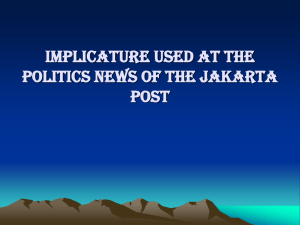
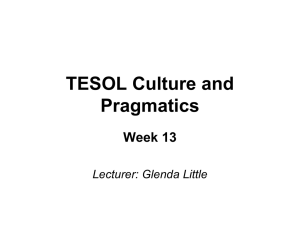
![semantics &pragmatics latest[1]](http://s3.studylib.net/store/data/007130838_1-7e4c75a7628e3786b08385136363c253-300x300.png)

